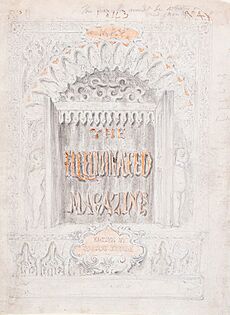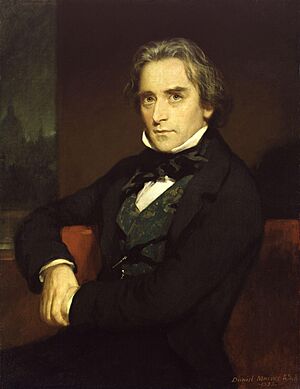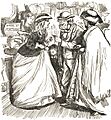Douglas William Jerrold facts for kids
Douglas William Jerrold (born 3 January 1803 – died 8 June 1857) was an English writer and a person who wrote plays (a dramatist). He was known for his clever wit and sharp writing.
Contents
Early Life and First Steps
Douglas Jerrold's father, Samuel Jerrold, was an actor who managed a small theatre. Douglas was born in London, but his family moved to Sheerness when he was young. He sometimes acted in plays as a child, but he wasn't very interested in becoming an actor like his father.
When he was ten, in 1813, Douglas joined the Navy as a midshipman on a ship called the Namur. He served until 1815, when a peace treaty ended the Napoleonic Wars. He didn't see much fighting, but he always loved the sea.
After his time in the Navy, his family faced financial difficulties. In 1816, they moved to London, and Douglas started working as a printer's apprentice. This meant he learned how to set type for printing. By 1819, he became a compositor at a newspaper office. He had already started writing short stories and poems for magazines. When his review of an opera was liked by his editor, he was asked to write more. This was the start of his career as a professional writer.
Becoming a Playwright
Douglas Jerrold wrote his first play, More Frightened than Hurt, when he was just 14 years old. It was performed in 1821. More plays followed, and by 1825, he was hired to write plays and funny short plays (farces) for a theatre called the Coburg Theatre. People even nicknamed him "the little Shakespeare" because of his talent!
In 1824, he married Mary Swan. He continued to write plays and work as a journalist. For a short time, he even owned a small Sunday newspaper.
The Success of Black-Eyed Susan
In 1829, Douglas Jerrold wrote a very successful play called Black-Eyed Susan; or, All in the Downs. It was a melodrama, a type of play with lots of exciting events and strong emotions. The play was about unfairness in the Navy and became hugely popular.
At this time, Britain was going through big changes, including arguments about laws that affected poor people and calls for fairer government. Black-Eyed Susan showed clear characters representing good and evil, rich and poor. It had a serious main story with funny parts to keep the audience entertained. The play was a massive hit! The theatre manager made a lot of money, and the actor who played the main character became famous. Douglas Jerrold didn't get rich from it, but his reputation as a great playwright was set.
After this success, other famous theatres wanted his plays. In 1836, he even became the manager of the Strand Theatre, but this didn't last long. During this time, he wrote his only sad play (tragedy), The Painter of Ghent, and even acted in it himself, but it wasn't very successful.
Later, in 1851, Douglas Jerrold acted in a play called Not So Bad as We Seem. Many famous people, including the famous writer Charles Dickens, were in it, and even Queen Victoria watched the performance. He continued to write clever and funny plays until 1854.
Journalism and Punch Magazine
Besides writing plays, Douglas Jerrold was a very active journalist. He wrote for many different magazines and newspapers, including Monthly Magazine, Blackwood's, and The Athenaeum.
His most famous work in journalism was for Punch magazine. He started writing for Punch in 1841, right from its second issue, and continued almost until his death. Punch was a funny and liberal magazine. Jerrold used a pen name, 'Q', to write witty articles that made fun of the important people and systems of the day.
It was in Punch that he published his popular series, Mrs Caudle's Curtain Lectures, in the 1840s. These were funny stories about a wife complaining to her husband in bed. They were so popular they were later published as a book.

Douglas Jerrold also started and edited several other magazines, like the Illuminated Magazine and Jerrold's Shilling Magazine. From 1852, he became the editor of Lloyd's Weekly Newspaper, which grew hugely popular under his leadership, reaching a circulation of 182,000 copies!
One interesting fact is that on 13 July 1850, writing as 'Mrs Amelia Mouser' for Punch, he wrote about the upcoming Great Exhibition of 1851. He used the phrase "the palace of very crystal" to describe the proposed building. From that day on, the famous building designed by his friend Joseph Paxton became known as The Crystal Palace.
Later Life and Legacy
Douglas Jerrold passed away at his home in London on 8 June 1857. He was buried at West Norwood Cemetery. Famous writer Charles Dickens was one of the people who carried his coffin. Dickens also gave public readings and performances to raise money for Jerrold's wife after his death.
Douglas Jerrold was a small man, and in his later years, he was quite bent over. He had strong, expressive features, with thin, humorous lips and bright blue eyes under bushy eyebrows. He was quick and active, with the straightforward manner of a sailor. He was honest and open, always showing his feelings. While his writings could be cynical, in his private life, he was very generous.
In politics, he was a Liberal, meaning he supported freedom and fairness. He strongly believed in fighting against war, the luxury of powerful church leaders, and the death penalty.
Today, Douglas Jerrold is perhaps best known for his brilliant wit in conversation rather than just his writings. While his plays were very popular in his time, they are not often performed now. He was one of the first writers to focus on the lives of ordinary people in his plays, rather than just the rich and famous. He also helped to make sure that English plays were original, instead of just being copied from French ones. His play Time Works Wonders (1845) shows off his great skill in writing clever dialogue. His stories and sketches, often written week by week, are full of sharp observations and funny wit.
His eldest son, William Blanchard Jerrold, wrote about his father's life and edited some of his works. His grandson, Walter Jerrold, also edited collections of his stories and witty sayings. Douglas Jerrold's great-granddaughter, Audrey Mayhew Allen, wrote children's stories, including Gladys in Grammarland, which was inspired by Lewis Carroll's Alice in Wonderland books.
Works
Douglas Jerrold wrote many works. Here are some of his most well-known:
- Black-Eyed Susan (1829) - a play
- The Rent Day (1832) - a play
- Men of Character (1838) - a collection of stories
- Cakes and Ale (1842) - a collection of short papers and funny stories
- The Story of a Feather (1844) - a novel
- The Chronicles of Clovernook (1846) - a novel
- A Man made of Money (1849) - a novel
- St Giles and St James (1851) - a novel
- Punch's Letters to his Son (1843) - a series of papers
- Punch's Complete Letter-writer (1845) - a series of papers
- Mrs Caudle's Curtain Lectures (1846) - a very popular series of funny stories
A collection of his writings was published between 1851 and 1854.
Images for kids




